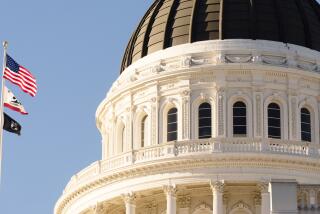Brown tax hike plan may bring in less than estimated
Reporting from Sacramento — Gov. Jerry Brown’s plan to raise taxes on sales and high earners could bring in billions of dollars less than he is counting on to help balance the state’s books, according to the Legislature’s main financial advisor.
Brown, who hopes to put his proposal before voters in the fall, says it would generate nearly $6.9 billion annually to help close the budget deficit over the next five years. But the nonpartisan Legislative Analyst’s Office estimates that it is likely to generate just $4.8 billion in the 2012-13 budget year and about $5.5 billion in subsequent years.
The governor’s plan would boost the state sales tax by half a cent and increase levies on incomes of $250,000 or more for the next five years. It is the linchpin of the $92.6-billion spending blueprint that Brown unveiled last week. If voters reject the tax measure, Brown says, it would mean billions less for schools next year and more cuts in both of California’s public university systems.
A joint letter from Department of Finance director Ana Matosantos and Legislative Analyst Mac Taylor released Monday says that predicting how much Brown’s tax measure could yield is difficult because of its partial dependence on income taxes. The money the state receives from top taxpayers can vary wildly from year to year.
“Their capital income is highly volatile from one year to the next,” the letter states. “…Given this volatility, estimates of the revenues to be raised by this initiative will change between now and the November 2012 election.”
Brown says the proposed taxes would virtually eliminate the state’s budget deficit in five years. But the analyst’s office was more guarded in its projections, estimating that California will face deficits of more than $5 billion a year through 2017.
Department of Finance spokesman H.D. Palmer said the Brown administration assumes higher incomes and capital gains from the state’s top earners in coming years than the analyst does.
“Currently, 1% of the total number of personal income tax returns will generate more than 40% of the overall personal income tax receipts,” Palmer said. “So small swings can swing your assumptions.”
Jason Sisney, a spokesman for the analyst’s office, said the two parties also have differing interpretations of federal tax law.
“The finance revenue model assumes that the Bush tax cuts will expire in 2012, as they are currently scheduled to do. Our forecast assumes that they are extended,” Sisney said.
Palmer said the administration would release revised revenue projections in May, after April tax receipts are counted.
Some economists say Brown’s administration may actually be underestimating California’s economic recovery.
Christopher Thornberg, a principal at the Los Angeles consulting firm Beacon Economics, expects the state to pull in more revenue than the administration has forecast.
“Their revenue numbers for next year are absurdly low,” Thornberg said. “They seem to be running this on a worst-case scenario.”
Times staff writer Chris Megerian contributed to this report.
More to Read
Sign up for Essential California
The most important California stories and recommendations in your inbox every morning.
You may occasionally receive promotional content from the Los Angeles Times.










